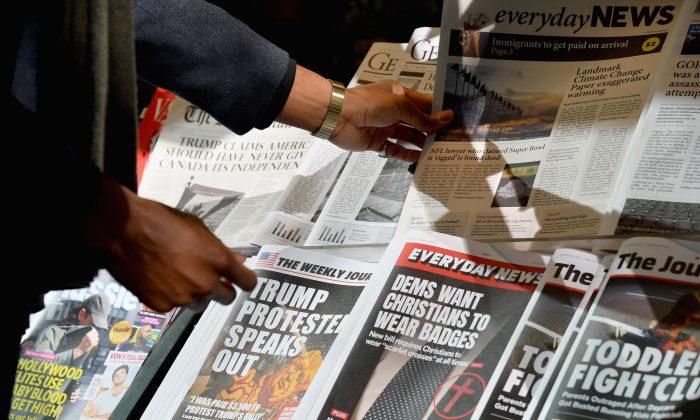Commentary
Part I of this series about America’s “Ministry of Truth” covered the media narratives of Soviet Russia, George Orwell’s “Nineteen Eighty-Four,” and that of the United States—a narrative fueled by a devastating comment made by New York Gov. Andrew Cuomo, who declared that “America was never that great.”
The Soviet Russia narrative was supported by an immense staff responsible for maintaining the newspaper Pravda’s circulation of 11 million, a task perhaps not as difficult as it sounds, given that “the most striking aspect of Soviet newspapers [was] their indifference to the news,” according to Robert G. Kaiser’s 1976 analysis, in his book “Russia: The People and the Power.“
Orwell’s narrative was symbolized by a building that dwarfed everything else in sight: “It was an enormous pyramidal structure of glittering white concrete, soaring up, terrace after terrace, 300 meters into the air. From where Winston stood, it was just possible to read, picked out on its white face in elegant lettering, the three slogans of the Party: WAR IS PEACE, FREEDOM IS SLAVERY, IGNORANCE IS STRENGTH.” Deciphering these words unveiled mysteries lurking behind The Party’s existence and remain hugely instructive today, as we shall see.
Which brings us to the American narrative, preserved by professors ensconced in the country’s most famous universities in departments of communication or journalism. Regardless of their location, the storyline preached by U.S. schoolmarms varies hardly an iota, from Stanford to Columbia, from the University of North Carolina (UNC) to the University of Southern California (USC), and in nearly every institution in between, with staffs that might even include a few misanthropes who insist that 9/11 was a hoax perpetrated by the Bush administration.
Party Affiliation
Determining the political beliefs of our chattering class’s mentors isn’t as straightforward as it may seem. But given the polarization of America’s political parties over the past generation, party affiliation has become an increasingly more important predictor of political attitudes, especially among elites. In fact, group-think scenarios flash through one’s mind when viewing recent research on this subject.A recent study published in Econ Journal Watch shows why. The authors examined Democrat-to-Republican ratios across five disciplines, including journalism, at 40 leading universities, including some of the most prestigious institutions in the country. Although unlikely to produce an “aha!” moment, their findings still have the capacity to shock.
For instance, Democrats outnumber Republicans across the board by a ratio of 11.5-to-1, leading the authors to remark that “in most humanities/social-science fields, a Republican is a rare bird.” Furthermore, “in 42 percent of the departments, Republican registrants were as scarce as or scarcer than left minor-party registrants.” Which is to say that for most departments, a Republican has the status of a museum piece.
This conclusion is reinforced by data strictly from journalism departments, the overall ratio for which is 20-to-1 Democrat-to-Republican, but regresses further when specific institutions are considered. Thus, at Columbia, the Democrat-to-Republican ratio is 21-to-0; Cornell, 12-to-0; UC–Berkeley, 12-to-0; USC, 19-to-1; UNC, 19-to-1; New York University, 15-to-1; and UC–Santa Barbara, 20-to-0.
The grand finale is reserved for a morsel of data reflected in the above ratios, which is that 60 percent of the 25 journalism departments they studied had no Republicans at all. An encore tidbit is that younger faculty (assistant professors) are the least likely to be Republican—just when one might think it’s impossible for higher education to be more saturated with Democrats.
Impartiality
None of this would make any difference if rulers who oversee these fiefdoms inculcated values that emphasize objectivity (or at least attempts to be impartial), suppression of personal opinions, and ordinary civility, regardless of partisan preferences.Unfortunately, the behavior of many journalists suggests this is hardly the case, especially considering that negative reporting of President Donald Trump sits at around 92 percent, a percentage that would be drastically improved merely by repeated coin-flipping.
Admittedly, there are gaps in our data-sequence, but given the contemptuous and often profanity-laced diatribes by Democratic media elites regularly scorching airwaves and print media over the past two years, a few inferences here and there about journalists’ upbringing and peer groups seem justified.
Thus, when Jim Acosta is relieved of his White House press credentials for habitual boorishness, along with the practice of asking questions that follow the “have you stopped beating your wife” template; when April Ryan shouts the question “Are you a racist?” at the president; and when both are unapologetically defended by their media colleagues, one may safely assume America’s Ministry of Truth is functioning in ways not entirely unexpected by its commissars.
And as a reminder, there’s that pesky 92 percent negative reporting thing going on.
This suggests that even the term “group-think” fails to describe the process; “lock-step” does more heavy lifting, more fully conveys Minitrue’s approach—especially when it comes to deciding what is news and how it should be reported. This is the next topic in our review of America’s Ministry of Truth.
Marvin Folkertsma is a retired professor of political science and a fellow for American studies with The Center for Vision & Values at Grove City College. The author of several books, his latest release is a novel titled “The Thirteenth Commandment.”
Views expressed in this article are opinions of the author and do not necessarily reflect the views of The Epoch Times.





